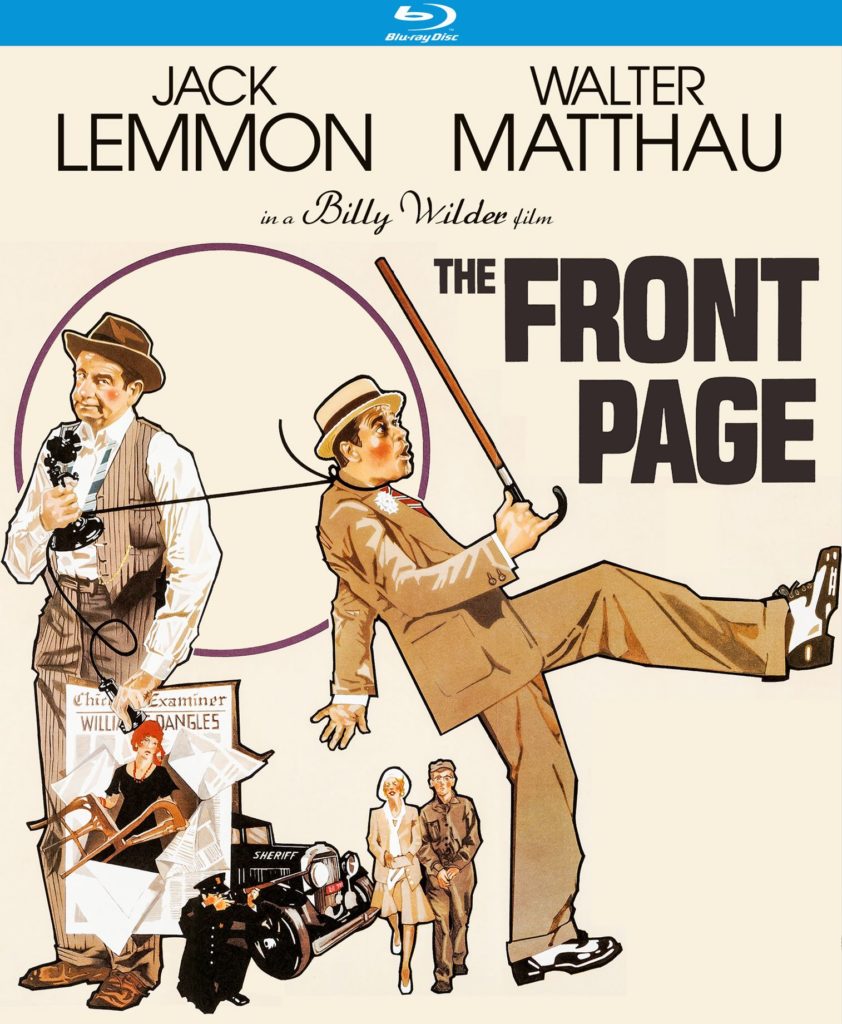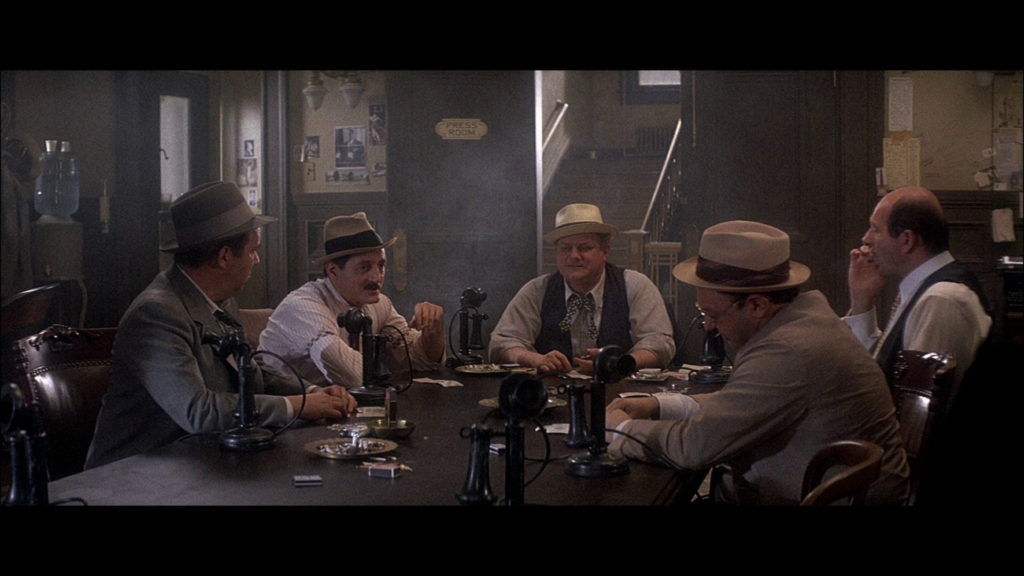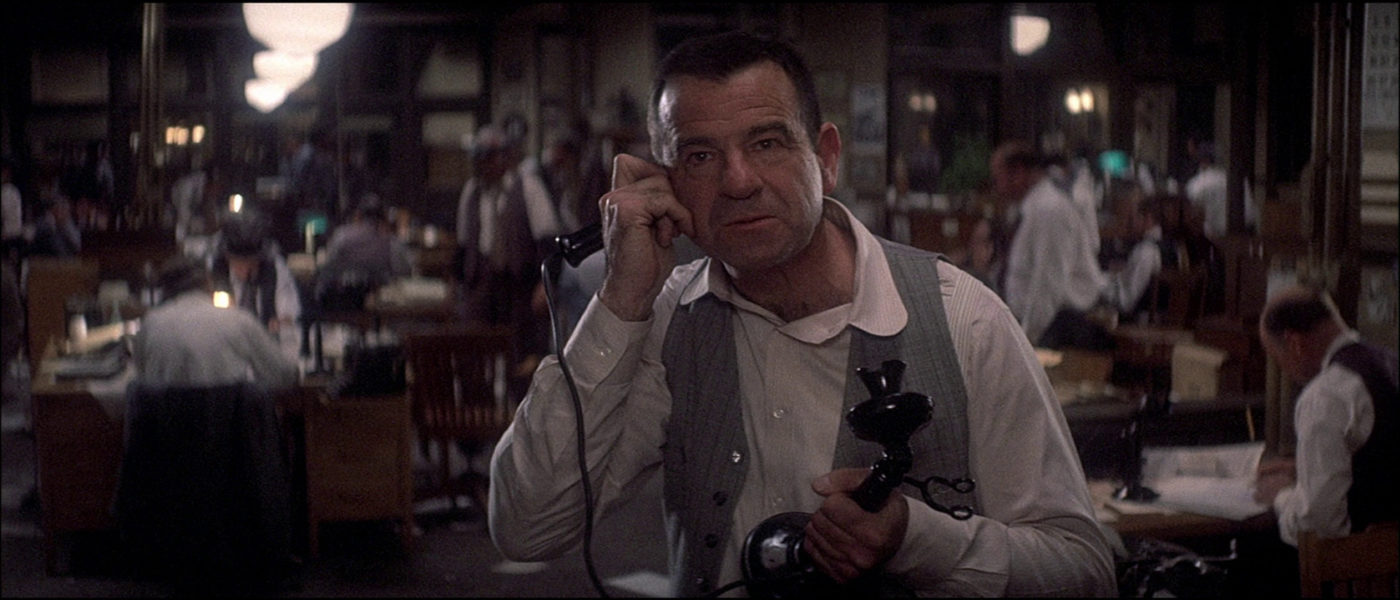The 1920’s Roar Again In Third Film Of Chicago Newspaper Stage Classic

DIRECTED BY BILLY WILDER
STREET DATE: AUGUST 6TH, 2019/KINO LORBER STUDIO CLASSICS
My mom was an English, film, and drama teacher at a rural Wisconsin high school whose annual Spring project was staging a rapid-paced, dialogue-driven comedy in the gym-auditorium of the nearby middle school. In a space that doubled as a screening room for black-and-white movies, projected on white canvass curtains in 8 and 16 mm, the teenage kids of tractor drivers, field workers, and livestock herders recreated the pace, energy, and wit of a style of entertainment that had dominated the media of stage, radio, and film since the late 1920’s. Following three fun and energetic, mid-March, Thursday-Friday-and-Saturday evening performances of You Can’t Take It With You, The Man Who Came To Dinner, and Arsenic and Old Lace, the Marshall Players even one year attempted a one-night-only, heavily sanitized but (mostly) spiritually intact adaptation of the 1928 Broadway play that practically revitalized and reinvented the twentieth century stage comedy: Ben Hecht and Charles MacArthur’s The Front Page.
While I don’t remember specifically much about this mid-1980’s high school production beyond a bunch of older kids scrambling frantically over a stage in funny hats shouting “gosh!” and “darn!” — as substitutes for other less socially acceptable four-word exclamations — it made enough of an impression on my eight-year-old sensibility to recognize and connect the story, setting, and characters to a somewhat later viewing of the Howard Hawks comedy His Girl Friday (1940). Possibly taking a cue from that version of the play, which famously switched the gender of one of the main characters, my mom cast both boys and girls in the reporters’ parts, cast female teachers in the roles of the sheriff and mayor, and even made escaping condemned convict Earl Williams an Evelyn and streetwalker Molly Malloy a street flower vendor named Marvin. Hildy remained a young man, but Walter Burns — as played by my siblings’ onetime babysitter Colleen — became a white-wigged, bifocaled iron maiden referred ominously to as “Madame Burns”.
As for any objection to prefacing this review of Billy Wilder’s mid-1970’s filming of The Front Page with a seemingly random and apparently unrelated anecdote from my childhood — honoring the inventiveness and taste of my late mother as opposed to immediately addressing Kino Lorber’s new Blu-ray — I will respond in verbal terms that only the third filming of the venerable stage comedy was able to directly address from the gallows of the Cook County Jail below to the second floor Press window of the Criminal Courts Building above: SCREW YOU.

In keeping with the spirit of that CAPSLOCK remark above, Ben Hecht and Charles MacArthur’s The Front Page burst upon the Broadway season of 1928 with a level of irreverence, pace, and profanity that had never before been witnessed by the general public. Former Chicago newshounds Hecht and MacArthur brought the turbulent days of America’s Sin Capital alive for theatergoers who had thrilled to gruesome headlines screaming Gangland Slaying! Gallows’ Death! Sidewalk Explosion! every morning the past decade over ink-stained toast and fresh print-fumed coffee. Its 1931 filming, from producer Howard Hughes and director Lewis Milestone, opened up the one-set action of the play, while retaining the frantic pace of the stage production, and solidified the property’s subsequent (and inescapable) influence on film genres ranging from the gangster film to the screwball comedy. The latter genre received a post-Depression, pre-World War II boost with its 1940 remake His Girl Friday, in which director Howard Hawks transformed the cutthroat journalism comedy melodrama into a comedy melodrama of cutthroat marital relations by substituting star reporter Hildebrandt for a Hildegarde Johnson and making Walter Burns both her editor and former husband.
And while both film versions retained The Front Page’s essential irreverence, with His Girl Friday ramping up the rat-a-tat pace to dizzying levels rarely captured on film before or since, the crucial Chicago-ness of the original play was downplayed in the 1931 film (laid “in a mythical kingdom” due to censorship reasons) and entirely ignored in 1940. As such, and as a mid-seventies period piece that played on the Vietnam and Watergate era’s curious run of four decades’ displaced anti-nostalgia, Billy Wilder’s third 1974 film of The Front Page is the first to intentionally evoke the era and setting of the original play squarely in the Murder City and Scandal Sheet milieu of the Roaring Twenties.
The opening credits play over the backwards-pressed typesetting — from moveable inkblocks to a headline-streaming paper-flow — announcing the early morning hanging of “cop killer” Earl Williams. Hard-nosed Chicago Examiner city editor Walter Burns (Walter Matthau) frantically attempts to locate absent star reporter Hildy Johnson (Jack Lemmon), who casually strolls into Burns’s office on the eve of the hanging to announce his upcoming marriage to one Peggy Grant (Susan Sarandon) and his leaving behind of the newspaper game to take a job with his future father-in-law’s advertising firm back East.
Neatly sidestepping his boss’s verbal harangues and underhanded tactics to keep him on the job, Hildy visits his old reporting pals at the Criminal Courts Building second-story Press Room, overlooking the very gallows’ yard of the Cook County Jail where the hanging of Earl Williams (Austin Pendleton) is scheduled, for a final farewell. Soon after, however, the most infamous condemned convict of the day inexplicably breaks out of jail, leading cops on a citywide manhunt and the reporters in pursuit of a literally breaking story.
Following a few quick leads of his own, Hildy, unable to resist the lure of a bleeding lede, has the story himself suddenly break through the second-story window from a hanging drainpipe directly into the emptied Press Room. The diminutive Williams is promptly stashed in effete Bensigner’s giant rolltop desk, after which Williams’ visiting moll Molly Malloy (Carol Burnett) dramatically leaps out the same broken window when mercilessly browbeaten by the returning “gentlemen of the press” over Williams’ whereabouts.
As if on cue, Burns is revealed nonchalantly leaning against the Press Room entrance as the rival reporters rush out: the city editor poised and ready to take charge of the story, Hildy’s lingering reluctance to write it, and public “malfeasance, misfeasance, and non-feasance” in the corporeal forms of Chicago’s corrupt sheriff (Vincent Gardenia) and opportunistic mayor (Harold Gould).
In the original play, Walter Burns’s Diabolus ex Machina described above — arriving two-thirds of the way through the play’s second (of three) acts — was the first appearance of what until that point had been an offstage and tinny bellow over a phone receiver. (“Why, your language is shocking, Mr. Burns!”) The character’s much delayed entrance provided a suitably devilish buildup to a character we would by that point believed entirely lacks the humanity to respond to or even register the shocking sight of a scantily clad woman leaping out a window. As played with the distinctive slouch-glower of the one-and-only Walter Matthau, whose laidback malevolence provides an instructive study in contrast to Adolph Menjou in 1931’s cold malign and Cary Grant in 1940’s brisk cruelty, the anything-for-a-headline megalomania of the character receives a disconcerting degree of lived-in (dis)comfort that fits the character lead like a soiled, slippery glove. Barking orders with the offhand ease of a carnival barker one minute and seething seductive, oily snake charm the next, Matthau’s hangdog villainy plots and double-crosses with an infectious anti-heroism keenly resonant with both 1920’s Chicago and 1970’s Washington. (Nixon and his cronies, we feel, would stand just about as much a chance as their fictional counterparts in The Front Page’s Sheriff and Mayor.)

Similarly, Jack Lemmon as Hildy Johnson, although possibly a few years too old for the part as written, nevertheless brings the full force of his eccentric energy to bear on the classic headline hunter relishing an exclusive story as much as the prospect of a bombastic banner in bold type. Full of brim and comic business, Lemmon’s Hildy struts and jaunts across the widescreen production vistas of the Office and Press Room, humming standards of the day and swinging a walking stick with the up-tempo élan of a downtown dandy. Given their long screen partnership, which had begun with Wilder’s 1966 The Fortune Cookie, broke out with 1968’s smash-hit The Odd Couple, and continued through the Matthau-starring, Lemmon-directed Kotch (1971), Lemmon as Hildy and Matthau as Burns play onscreen with the veteran pair’s cosmic level of chemistry born of the individualistic actors’ respectively irreducible talents.
In keen support of all these goings-on is a laundry list of some of the best working character actors of the day: Charles Durning, Herb Edelman, David Wayne, Allen Garfield, Dick O’Neill, Lou Frizzell, Noam Pitlick; in all, providing a hilarious hodgepodge of macho and not-so-macho alternatives in the elevated dank dungeon that is the second-floor Press Room. Harold Gould proves a suitably slick evil mayor — sending reprieve-laden process server Plunkett (Paul Benedict in unusually rare moronic form) to the not-so-publicly minded public servant’s privately-staked Chinese whorehouse with the second-hand use of his “chopsticks” — and three-time Wilder veteran Cliff Osmond, as the gallows-constructing officer, gets in more than a few zingers, but Vincent Gardenia as “reform the reds with a rope” Sheriff Peter B. Hartman (“’B’ for ‘brains’”) nearly steals the show with his bushy tuft-browed apoplexy bordering on a sustained cardiac event. With Billy May’s flavorful period score, cinematographer Jordan Cronenweth’s glowing imagery, and all these chaotically coordinated characters rushing through production designer Henry Bumstead’s lavishly run-down sets, this third version of The Front Page definitively foregrounds the journalistic mayhem of the era with the combined character of its setting, scripting, and performances.
Never given its proper due, even by its own director and co-writer Billy Wilder, Kino Lorber’s new Blu-ray will possibly inspire reappraisal for its overlooked qualities and considerable charms. Unfairly criticized in comparison to the gold standard of His Girl Friday, especially regarding its more deliberate pacing, the whirlwind of overlapping dialogue of that previous version is keenly eschewed by Wilder and co-adaptor I.A.L. Diamond in favor of a ticker tape-like verbal stream of typewritten dialogue. What may sound slower to our ears allows the story to unfold with the moment-by-moment immediacy of a celluloid-captured newspaper pressing. And even the most consistently criticized aspect of 1974’s The Front Page, as heartily echoed through the years by the comic actress herself, becomes easier to accept if forced to consider the one un-funny character in a funny play, Molly Malloy, as being shrilly overplayed to fittingly melodramatic effect by the funniest comedienne of her era, Carol Burnett.
Echoing some if not all of these sentiments are audio commentators Michael Schlesinger and Mark Evanier, whose combined love for and passionate defense of this sometimes forgotten film may convince listeners of this The Front Page’s status as a neglected gem (even as many readers of this review may be now shaking their heads in disagreement). Also included are interviews with the film’s assistant director Howard G. Kazanjian and Wilder’s personal assistant Rex McGee, who speak at length about the production, Wilder’s working methods, and his relationships with the actors. Wilder and Diamond altered some of the material in adapting the play to film, cutting some characters and opening other situations to more logical dramatic effect. Actor Austin Pendleton, who played Earl Williams, expresses his gratitude to the director in his interview for expanding the key character’s role from the play.
Capturing Billy Wilder’s preferred later career canvass of the 2:35:1 widescreen, Kino Lorber’s Blu-ray preserves the filmic elements of those laterally-composed images with the broadsheet integrity that its Chicago 1920’s subject entertainingly lacked. But like the entrance of “Madame Burns” I witnessed as an eight-year-old watching my mother’s play, with the steel-rimmed “old lady” crossing the Press Room and casually flinging a lit cigar out the window that a romantically distraught florist had just leapt out of, the attitude, wit, and bow-tied “charm” of its era is admirably captured in the film and beautifully re-presented on this Blu-ray.
Images used in this review are credited to DVDBeaver.


